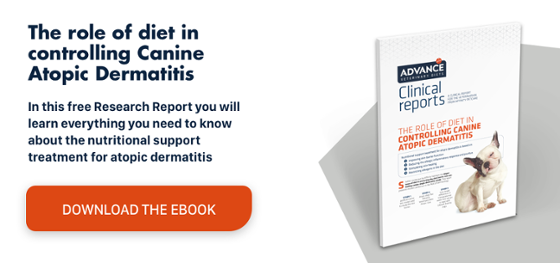Maintenance of canine atopic dermatitis with cyclosporin
Canine atopic dermatitis (CAD) affects approximately 10% of dogs, which makes it one of the most common skin conditions. It is a chronic skin disease that courses with pruritic inflammation and hypersensitivity, affecting both the dermis and the epidermis. CAD has a marked genetic component, but it is triggered by environmental allergens. It usually affects young dogs, although it can occur at any age.
CAD is a chronic disease without any known cure. However, there are some treatments that can relieve symptoms and prolong the interval between flare-ups. Accordingly, it is important to keep ectoparasites under strict control and prevent patients from getting too hot as both conditions can trigger a flare-up and aggravate the clinical signs.
Regular baths using a special shampoo are also recommended to control secondary infections, remove allergens from the skin and relieve inflammatory and pruritic symptoms. However, the key to controlling flare-ups and improving the patient’s quality of life is an appropriate drug therapy.
Pharmacological treatment of canine atopic dermatitis: cyclosporin
Various pharmacological treatments are available for canine dermatitis. Cyclosporin is one of the most widely used, as it is effective in over 80% of cases. It has a similar efficacy as glucocorticoids but with fewer side effects, as confirmed in a study1 by Novartis Animal Health that analysed a series of clinical trials involving about 799 dogs with atopic dermatitis. 84% of the sample were treated with cyclosporin, 20% with placebo, 9% with oral glucocorticoids and the remaining 3% with antihistamines.
Treatment duration ranged from 2 weeks to 6 months. The dogs’ lesions improved by 30–52% after 4 weeks, 53–84% after 6 weeks, and 52–69% after 16 weeks of treatment. The most frequent side effects were vomiting and diarrhoea observed in 15–25% of the subjects.
These results are thanks to the cyclosporin’s inhibitory action on calcineurin – an enzyme that plays an essential role in the genetic activation of canine dermatitis – and its ability to reduce the autoimmune response by inhibiting interleukins, especially IL-2 – a proinflammatory cytokine involved in the body's inflammatory reaction, establishing cellular immune memory and external and internal antigen recognition. Hence, cyclosporin not only provides relief from the symptoms of canine atopic dermatitis, but also helps increase the time between flare-ups.
In most cases, the recommended dose is 5 mg/kg of cyclosporin taken orally, preferably 2 hours before or after a meal to increase its absorption. One or two weeks after treatment, the clinical signs should start to subside and the patient will show some improvement. In order to obtain a higher concentration of cyclosporin in the blood, the simultaneous administration of 5–10 mg/kg of ketoconazole may also be indicated.
How should cyclosporin use be rationed in the long-term treatment of canine atopic dermatitis?
If cyclosporin has proven effective after about 4 weeks of treatment, the dose should be gradually reduced to the minimum needed to control the clinical signs of CAD. A study2 by researchers at the College of Veterinary Medicine at North Carolina State University found that increasing the administration intervals in the long-term treatment with cyclosporin is also effective.
To reach these conclusions, they selected 30 dogs with atopic dermatitis and gave them 5 mg/kg of cyclosporin every day for 4 weeks. The dogs were randomly allocated to one of two groups. In the first group, the cyclosporin dose was reduced monthly to 2.5 and then 1.25 mg/kg/day until obtaining a reduction in lesions of 50 and 75%, respectively. In the second group, the administration interval was increased to alternate days and then every 4 days until the same reduction in lesions was achieved as in the other group.
The results showed that at 4, 8 and 12 weeks there were no significant differences between the two groups in the improvement of the subjects’ lesions and pruritus. Nor were any differences in side effects. A reduction in the cyclosporin dose was achieved for 12 dogs in the first group and 13 in the second, indicating that once the disease is under control, the cyclosporin dose can be reduced or the administration interval extended while maintaining the same efficacy.
In any event, dose reduction will depend on each patient’s clinical response to treatment. Cyclosporin levels do not normally need to be evaluated before reducing the dose, as noted in another study3 conducted by researchers at the Clinique Veterinaire Saint Bernard in France, but in some cases information on cyclosporin serum levels may be helpful.
In fact, measuring blood levels may prove useful in patients that do not respond to the drug therapy or when is a risk of toxicity from prolonged cyclosporin administration or co-administration with a medication that increases its bioavailability.
Treating the affected dog with Advance Veterinary Diets Atopic Diets may also reduce the use of medication, whilst maintaining all the benefits of the treatment.


